QuestionI have a simple covered fish bowl .. with 2 small lionhead goldfish .. the first 2 weeks there was no problems , but now theres a strong smell of amonia coming from the tank .. I was wondering if I can fix it and how? ... Your advice is appreciated .. thanks :) - Brittany'
AnswerHi Brittany;
It is a common belief that goldfish belong in bowls or small tanks. It is simply not true. Goldfish get 8 inches long and can live to be 10 years old or more. Those kept in small bowls or tanks only live a few weeks or so and are suffering terribly the whole time. Those poor fish simply need more room. Fish waste turns into ammonia. The ammonia is building up in there and is burning their gills, eyes and skin. They slowly suffocate as their gills become more and more damaged and they develop other problems. Goldfish need 10 gallons per fish and good filtration to avoid all that. Even if your little tank has a filter in it there is no way it can keep up in that small of a tank. The less water, the more concentration of deadly ammonia there is and the less area there is for gasses to exchange on the surface. When the tank is an appropriate size the ammonia is consumed by the beneficial bacteria that grows in the filter pads and on surfaces in the tank.
For now, until you can decide what to do, change all of the water in the tank immediately and then 50% every other day after that. Use a good water conditioner that helps the fishes' slime coating and helps with stress.
Here is more info on goldfish and what they need;
http://www.netpets.org/fish/reference/freshref/goldfaq.html
http://www.kokosgoldfish.com/care.html
http://www.petlibrary.com/goldfish/fishcare.htm
http://www.bellaonline.com/articles/art3503.asp
http://www.aquariumhobbyist.com/articles/Goldfish.html
http://www.flippersandfins.net/goldfishcaresheet.htm
When you do get a bigger tank you will want to know about "new tank syndrome". Here is my article about it to help you through it;
**********
New Tank Syndrome or Break-in Period
So you have a new tank and you filled it up, put the filter together, mounted the heater into place and turned on the lights. You have all the plants and decorations where you want them....
You are ready for fish.
But, your filter is not ready for a full tank of fish yet.
The filter is running and moving the water and cleaning out crud, right? Of course!
But a very important part of your filter is the part you can't see. An aquarium filter removes the larger visible stuff, but it also must remove the dissolved fish waste that turns into ammonia in the water. To do this, special bacteria must grow in the filter system and on the particles of gravel in the bottom of your tank. This process occurs even on a limited scale in little fish bowls that have no filter in them.
This is "New-Tank Syndrome" or the "Break-in Period". The entire process takes 6 to 8 weeks to complete because these "nitrifying" bacteria grow quite slowly.
Start off with only one or two hardy fish (no more than 2 total inches of fish) for every ten gallons of water and don't add more until the 6 to 8 weeks has gone by. Hard to be patient, but it is worth it to keep your fish alive and healthy. As a matter of fact, the bacteria cannot develop without fish in the tank. You can let that tank sit forever without fish in it, but as soon as the first fish goes in the process begins. Avoid changing the filter pads during break-in. This removes the bacterial colonies that are essential to a balanced aquarium. You can rinse the filter pad out in a container of aquarium water. This will preserve most of the bacteria colonies while still allowing your filter to flow freely. Even using bacteria additives and water conditioners when you first set up the tank will not make a tank begin the cycle by itself. If there are no fish to provide food (fish waste) for the bacteria, the beneficial bacteria cultures will die and you will have to start the colonies all over again once fish are added to the tank. Once the tank has completed the initial cycle, you can change the filter pads every 4 weeks or so. But for now, just rinse them.
Feed your new fish VERY lightly. Any excess food will cause additional waste your system cannot afford to have right now. If you see food floating around or lying on the plants and gravel after five minutes, too much food is going into the tank. Cut back a little each time you feed until it is ALL gone 5 minutes after you feed them. Feed them once a day.
During this "break-in period" your tank will become cloudy and milky looking. You may have to tolerate this for the entire break-in period but it is only temporary. Changing 25% of the water three times a week until the break-in period is over helps a great deal. Changing water reduces the ammonia and nitrites that rise while the bacteria continues to multiply. If ammonia and/or nitrites become too high, your fish will become stressed and possibly die. Use a good water conditioner when you replace the water and make sure it is the right temperature to avoid shocking your fish.
When the break-in is over after 6 to 8 weeks and there are no nitrites or ammonia present in the water you can slowly add more fish. Add one or two every week until you reach the desired population. This allows the bacteria to adjust to the new population every time before adding more. Monitor the nitrites and ammonia to be sure they don't come up. If they do, make a 25% water change and check them again. Don't add the next fish until the levels are down again.
The safe maximum population for any size tank is one inch of adult fish for every gallon of water in the tank. Do some research to be sure of the fish you are interested in. Even though they are small when you buy them, you have to base your population calculations on full-sized adult fish. Many hobbyists have up to two inches per gallon but this can be risky. If a water quality issue arises or a disease occurs it will spread fast and furious in an over-populated tank. In any case, 25% water changes every week to two weeks are absolutely essential for the health of your fish.
Following these guidelines will help you get your new tank on the right track.
**********
At Your Service;
Chris Robbins
Come on over and join us on the freshwater fish forum at About.com to get even more information too;
http://freshaquarium.about.com/od/questionsanswers/a/naavigateforum.htm

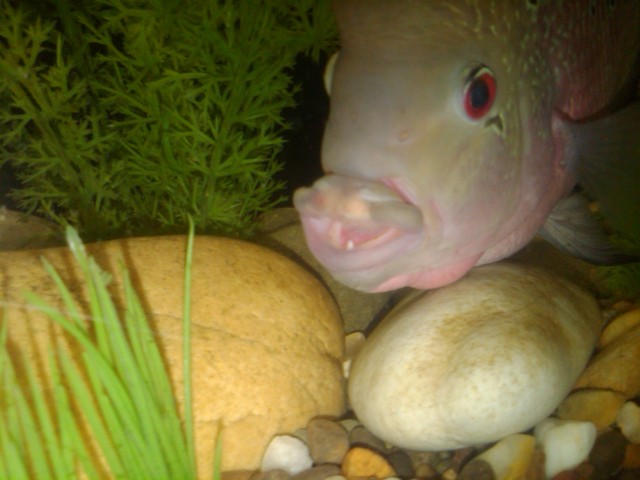 Sick Flowerhorn
Question
Swollen Lips
I have a beautiful Flowerhorn whi
Sick Flowerhorn
Question
Swollen Lips
I have a beautiful Flowerhorn whi
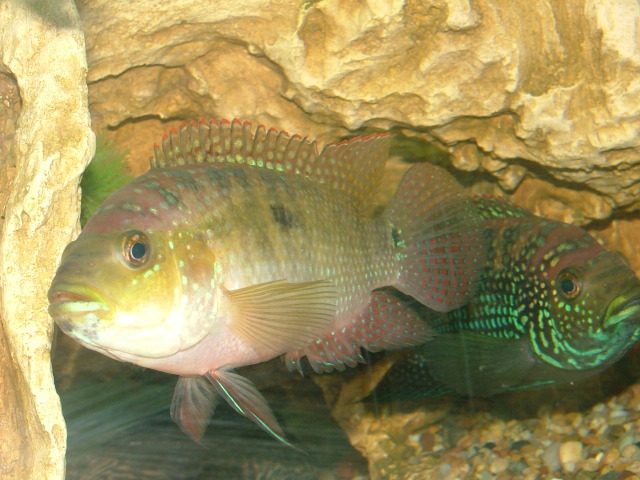 What sex are my Jack Dempseys?
Question
Jack Dempseys
Good morning MR. Coleman.
What sex are my Jack Dempseys?
Question
Jack Dempseys
Good morning MR. Coleman.
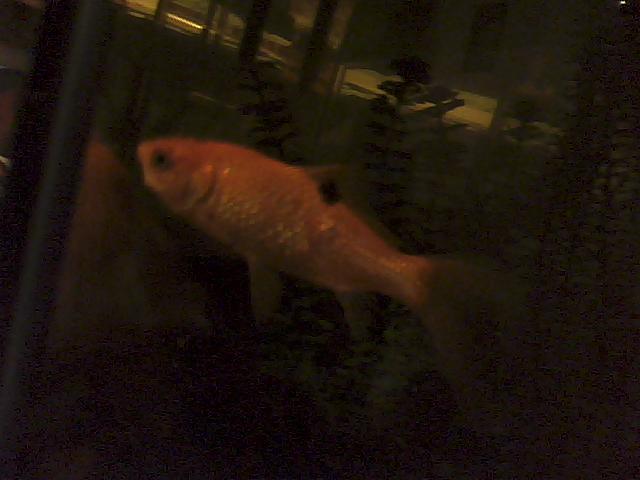 why is my fish dying?
QuestionQUESTION: Hi- my fish,Shrek, has been swi
why is my fish dying?
QuestionQUESTION: Hi- my fish,Shrek, has been swi
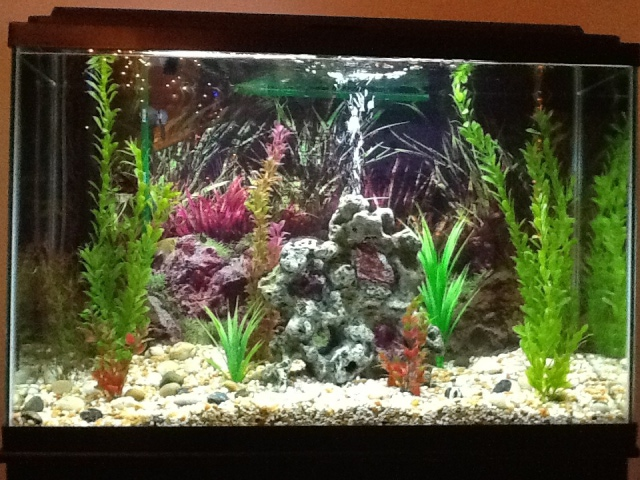 Testing water quality
Question
My tank
I have a 45 gallon tank with 4
Testing water quality
Question
My tank
I have a 45 gallon tank with 4
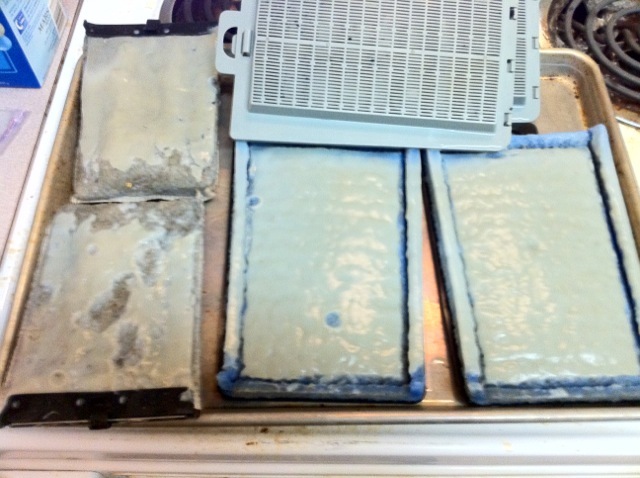 Urgent - Fish are really sick
Question
Gray slime on filters
My mom passed away and I
Urgent - Fish are really sick
Question
Gray slime on filters
My mom passed away and I